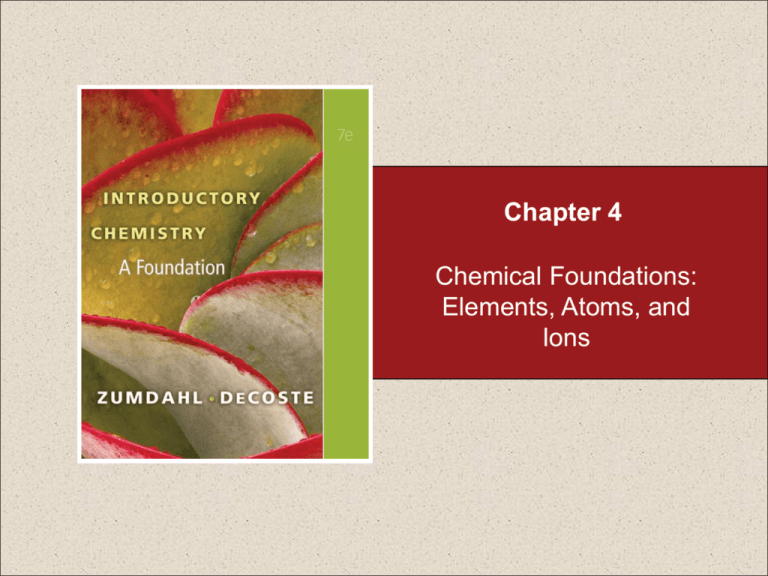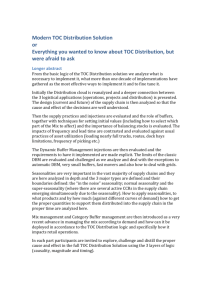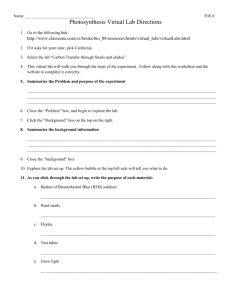
Chapter 4
Chemical Foundations:
Elements, Atoms, and
Ions
Section 4.1
The Elements
4.1
4.2
4.3
4.4
4.5
4.6
4.7
4.8
4.9
4.10
4.11
The Elements
Symbols for the Elements
Dalton’s Atomic Theory
Formulas of Compounds
The Structure of the Atom
Introduction to the Modern Concept of Atomic
Structure
Isotopes
Introduction to the Periodic Table
Natural States of the Elements
Ions
Compounds That Contain Ions
Return to TOC
Copyright © Cengage Learning. All rights reserved
2
Section 4.1
The Elements
•
•
•
115 known: 88 found in nature, others are man
made.
Just as you had to learn the 26 letters of the
alphabet before you learned to read and write,
you need to learn the names and symbols of
the chemical elements before you can read and
write chemistry.
It’s just like learning a foreign language. You
have to learn the vocabulary and grammar
before you can read and write sentences!
Return to TOC
Copyright © Cengage Learning. All rights reserved
3
Section 4.1
The Elements
Return to TOC
Copyright © Cengage Learning. All rights reserved
4
Section 4.1
The Elements
How the Term Element is Used
•
•
•
•
Could mean a single atom of that element (Ar
or H).
Could mean molecules of an element (H2,
which is hydrogen found in its natural state).
Could mean atoms of elements that are
present in some form (sodium found in the
human body).
Look at each particular case to determine its
proper use.
Return to TOC
Copyright © Cengage Learning. All rights reserved
5
Section 4.1
The Elements
•
•
•
Each element has a unique one- or two-letter symbol.
First letter is always capitalized and the second is not.
The symbol usually consists of the first one or two
letters of the element’s name.
•
Examples:
Oxygen
Krypton
O
Kr
Sometimes the symbol is taken from the element’s
original Latin or Greek name.
Examples:
Gold Au aurum
Lead Pb plumbum
Return to TOC
Copyright © Cengage Learning. All rights reserved
6
Section 4.1
The Elements
Names and Symbols of the Most Common Elements
Return to TOC
Copyright © Cengage Learning. All rights reserved
7
Section 4.1
The Elements
1. Most natural materials are mixtures of pure
substances.
2. Pure substances are either elements or
combinations of elements called compounds.
3. A given compound always contains the same
proportions (by mass) of the elements.
Return to TOC
Copyright © Cengage Learning. All rights reserved
8
Section 4.1
The Elements
Law of Constant Composition
•
A given compound always has the same
composition, regardless of where it comes
from.
There is always one oxygen for each two hydrogens
in a molecule of water [Omol.wt = 16; Hmol.wt. = 1 X 2
H’s per water]
Water always contains 8 g of oxygen for every 1 g of
hydrogen.
Carbon dioxide always contains 2.7 g of oxygen for
every 1 g of carbon.
Return to TOC
Copyright © Cengage Learning. All rights reserved
9
Section 4.1
The Elements
Dalton’s Atomic Theory (1808)
1. Elements are made of tiny particles called
atoms.
2. All atoms of a given element are identical.
3. The atoms of a given element are different
from those of any other element.
4. Atoms of one element can combine with
atoms of other elements to form compounds.
A given compound always has the same
relative numbers and types of atoms.
Return to TOC
Copyright © Cengage Learning. All rights reserved
10
Section 4.1
The Elements
Dalton’s Atomic Theory (continued)
5. Atoms are indivisible in chemical
processes. Atoms are not created or
destroyed in chemical reactions. A
chemical reaction simply changes the way
the atoms are grouped together.
Return to TOC
Copyright © Cengage Learning. All rights reserved
11
Section 4.1
The Elements
Scanning Tunneling Microscope
Return to TOC
Copyright © Cengage Learning. All rights reserved
12
Section 4.1
The Elements
Concept Check
Which of the following statements regarding
Dalton’s atomic theory are still believed to be
true?
I. Elements are made of tiny particles called atoms.
II. All atoms of a given element are identical.
III. A given compound always has the same relative
numbers and types of atoms.
IV. Atoms are indestructible.
Return to TOC
Copyright © Cengage Learning. All rights reserved
13
Section 4.1
The Elements
Chemical Formulas Describe Compounds
•
•
Compound – distinct substance that is
composed of the atoms of two or more
elements and always contains exactly the
same relative masses of those elements.
Chemical Formulas – expresses the types of
atoms and the number of each type in each
unit (molecule) of a given compound.
Return to TOC
Copyright © Cengage Learning. All rights reserved
14
Section 4.1
The Elements
Rules for Writing Formulas
1. Each atom present is represented by its element
symbol.
2. The number of each type of atom is indicated by a
subscript written to the right of the element symbol.
3. When only one atom of a given type is present, the
subscript 1 is not written.
Return to TOC
Copyright © Cengage Learning. All rights reserved
15
Section 4.1
The Elements
Exercise
The pesticide known as DDT paralyzes insects by
binding to their nerve cells, leading to uncontrolled firing
of the nerves. Before most uses of DDT were banned in
the U.S., many insects had developed a resistance to it.
Write out the formula for DDT. It contains 14 carbon
atoms, 9 hydrogen atoms, and 5 atoms of chlorine.
C14H9Cl5
Return to TOC
Copyright © Cengage Learning. All rights reserved
16
Section 4.1
The Elements
J. J. Thomson (1898—1903)
•
•
Postulated the existence of electrons using
cathode-ray tubes.
The atom must also contain positive particles
that balance exactly the negative charge
carried by particles that we now call electrons.
Return to TOC
Copyright © Cengage Learning. All rights reserved
17
Section 4.1
The Elements
Cathode-Ray Tube
e-
+
Return to TOC
Copyright © Cengage Learning. All rights reserved
18
Section 4.1
The Elements
William Thomson (Plum Pudding Model)
1824-1907
•
Reasoned that the atom
might be thought of as a
uniform “pudding” of
positive charge with
enough negative
electrons scattered
within to counterbalance
that positive charge.
Return to TOC
Copyright © Cengage Learning. All rights reserved
19
Section 4.1
The Elements
Ernest Rutherford (1911)
•
•
•
•
1871-1937
Nobel Prize 1908
Explained the nuclear atom.
Atom has a dense center of positive charge
called the nucleus.
Electrons travel around the nucleus at a
relatively large distance.
A proton has the same magnitude of charge as
the electron, but its charge is positive.
Return to TOC
Copyright © Cengage Learning. All rights reserved
20
Section 4.1
The Elements
Rutherford and Chadwick (1932)
•
•
Most nuclei also contain a neutral particle
called the neutron.
A neutron is slightly more massive than a
proton but has no charge.
Return to TOC
Copyright © Cengage Learning. All rights reserved
21
Section 4.1
The Elements
http://micro.magnet.fsu.edu/electromag/java/rutherford/
Copyright © Cengage Learning. All rights reserved
Rutherford’s Experiment
Return to TOC
22
Section 4.1
The Elements
The atom contains:
•
•
•
Electrons – found
outside the nucleus;
negatively charged
Protons – found in the
nucleus; positive charge
equal in magnitude to
the electron’s negative
charge
Neutrons – found in the
nucleus; no charge;
virtually same mass as a
proton
Return to TOC
Copyright © Cengage Learning. All rights reserved
23
Section 4.1
The Elements
•
The nucleus is:
Small compared with the overall size of the
atom.
Extremely dense; accounts for almost all of
the atom’s mass.
Return to TOC
Copyright © Cengage Learning. All rights reserved
24
Section 4.1
The Elements
Return to TOC
Copyright © Cengage Learning. All rights reserved
25
Section 4.1
The Elements
Why do different atoms have different chemical
properties?
•
•
•
The chemistry of an atom arises from its
electrons.
Electrons are the parts of atoms that
“intermingle” when atoms combine to form
molecules.
It is the number of electrons that really
determines chemical behavior.
Return to TOC
Copyright © Cengage Learning. All rights reserved
26
Section 4.1
The Elements
Isotopes
•
•
•
Atoms with the same number of protons but
different numbers of neutrons.
Show almost identical chemical properties;
chemistry of atom is due to its electrons.
In nature most elements contain mixtures of
isotopes.
Return to TOC
Copyright © Cengage Learning. All rights reserved
27
Section 4.1
The Elements
Two Isotopes of Sodium
Return to TOC
Copyright © Cengage Learning. All rights reserved
28
Section 4.1
The Elements
Isotope Notation
Protons Neutrons Electrons
6
6
6
6
7
6
6
8
6
How many protons, neutrons and electrons
in each of the following:
protons neutrons electrons
23Na
11
12
11
7
7
7
14N
38Ar
18
20
18
35Cl
17
18
17
36Cl-1
17
19
18
56Fe
26
30
26
Return to TOC
Copyright © Cengage Learning. All rights reserved
29
Section 4.1
The Elements
Exercise
A certain isotope X contains 23 protons and 28
neutrons.
• What is the mass number of this isotope?
• Identify the element.
Mass Number = 51
Vanadium
Return to TOC
Copyright © Cengage Learning. All rights reserved
30
Section 4.1
Mendeleev’s
Table
Mendeleev’s
Table
The Elements
Russian chemist Dmitri Mendeleev
developed and published the
basic arrangement of the periodic
table between 1869 and 1871.
Mendeleev arranged the elements in order of
increasing relative atomic mass (protons had
not been discovered yet). The elements on the
modern periodic table are arranged in order of
increasing atomic number.
He also grouped elements with similar properties
into columns and rows so that the properties
of the elements varied in a regular pattern
(periodically).
2Copyright © Cengage Learning. All rights reserved
Return to TOC
31
Section 4.1
Mendeleev’s
Table
The Elements
2Copyright © Cengage Learning. All rights reserved
Return to TOC
32
Section 4.1
The Elements
The Periodic Table
•
•
•
Most elements are metals and occur on the left side.
The nonmetals appear on the right side.
Metalloids are elements that have some metallic and some
nonmetallic properties.
Return to TOC
Copyright © Cengage Learning. All rights reserved
33
Section 4.1
The Elements
The Periodic Table
Groups or Families
– elements in
the same
vertical
columns; have
similar
chemical
properties
Periods –
horizontal rows
of elements
Return to TOC
Copyright © Cengage Learning. All rights reserved
34
Section 4.1
The Elements
Physical Properties of Metals
1. Efficient conduction of heat and electricity
2. Malleability (they can be hammered into thin
sheets)
3. Ductility (they can be pulled into wires)
4. A lustrous (shiny) appearance
Magnesium
Platinum
Copyright © Cengage Learning. All rights reserved
Sliver
Gold
Copper
Return to TOC
35
Section
Section4.9
4.1
Natural
States and Elements
The Elements
•
•
Most elements are very reactive.
Elements are not generally found in
uncombined form.
Exceptions are:
• Noble metals – gold, platinum and silver
• Noble gases – Group 8
Helium
Neon
Copyright © Cengage Learning. All rights reserved
Argon
Krypton
Xenon
Return to TOC
36
Section
Section4.9
4.1
Natural
States and Elements
The Elements
Diatomic Molecules
•
Nitrogen gas contains N2
molecules.
Copyright © Cengage Learning. All rights reserved
• Oxygen gas contains O2
molecules.
Return to TOC
37
Section
Section4.9
4.1
Natural
States and Elements
The Elements
Diatomic Molecules
Return to TOC
Copyright © Cengage Learning. All rights reserved
38
Section 4.1
The Elements
Nonmetals
Phorphorus
Liquid
Nitrogen
Fluorine
Graphite
Selenium
Chlorine
Bromine
Sulfur
Return to TOC
Copyright © Cengage Learning. All rights reserved
39
Section
Section4.9
4.1
Natural
States and Elements
The Elements
•
•
Carbon Allotropes
Different forms of a given element.
Example:
Solid carbon occurs in three forms.
• Diamond
• Graphite
• Buckminsterfullerene
Return to TOC
Copyright © Cengage Learning. All rights reserved
40
Section
Section4.10
4.1
Ions
The Elements
•
Atoms can form ions by gaining or losing electrons.
Metals tend to lose one or more electrons to form
positive ions called cations.
Cations are generally named by using the name of
the parent atom.
Return to TOC
Copyright © Cengage Learning. All rights reserved
41
Section
Section4.10
4.1
Ions
The Elements
•
Nonmetals tend to gain one or more electrons to form
negative ions called anions.
•
Anions are named by using the root of the atom name
followed by the suffix –ide.
Return to TOC
Copyright © Cengage Learning. All rights reserved
42
Section
Section4.10
4.1
Ions
The Elements
Ion Charges and the Periodic Table
•
The ion that a particular atom will form can
be predicted from the periodic table.
Group or Family
Alkali Metals (1A)
Alkaline Earth Metals (2A)
Halogens (7A)
Noble Gases (8A)
Charge
1+
2+
1–
0
Return to TOC
Copyright © Cengage Learning. All rights reserved
43
Section 4.1
The Elements
Conductivity of Solutions Containing Ions
Return to TOC
Copyright © Cengage Learning. All rights reserved
44
Section
Section4.10
4.1
Ions
The Elements
Ion Charges and the Periodic Table
Return to TOC
Copyright © Cengage Learning. All rights reserved
45
Section
Section4.10
4.1
Ions
The Elements
Exercise
An ion with a 3+ charge contains 23 electrons.
Which ion is it?
a)
b)
c)
d)
Fe3+
V3+
Ca3+
Sc3+
Return to TOC
Copyright © Cengage Learning. All rights reserved
46
Section
Section4.10
4.1
Ions
The Elements
Exercise
A certain ion X+ contains 54 electrons and 78
neutrons.
What is the mass number of this ion?
133
Return to TOC
Copyright © Cengage Learning. All rights reserved
47
Section
Section4.11
4.1
Compounds
that Contain Ions
The Elements
•
•
Ions combine to form ionic compounds.
Properties of ionic compounds
High melting points
Conduct electricity
•
•
If melted
If dissolved in water
Return to TOC
Copyright © Cengage Learning. All rights reserved
48
Section
Section4.11
4.1
Compounds
that Contain Ions
The Elements
•
•
Ionic compounds are electrically neutral.
The charges on the anions and cations in the
compound must sum to zero.
Return to TOC
Copyright © Cengage Learning. All rights reserved
49
Section
Section4.11
4.1
Compounds
that Contain Ions
The Elements
Formulas for Ionic Compounds
•
•
Write the cation element symbol followed by the anion
element symbol.
The number of cations and anions must be correct for
their charges to sum to zero.
Return to TOC
Copyright © Cengage Learning. All rights reserved
50
Section
Section4.11
4.1
Compounds
that Contain Ions
The Elements
Concept Check
A compound contains an unknown ion X and
has the formula XCl2. Ion X contains 20
electrons. What is the identity of X?
a)
b)
c)
d)
Ti2+
Sc+
Ca2+
Cr2+
Return to TOC
Copyright © Cengage Learning. All rights reserved
51
Section
Section4.11
4.1
Compounds
that Contain Ions
The Elements
Concept Check
A member of the alkaline earth metal family
whose most stable ion contains 36 electrons
forms a compound with bromine. What is the
correct formula for this compound?
a)
b)
c)
d)
CaBr2
KrBr
RbBr
SrBr2
Copyright © Cengage Learning. All rights reserved
Return to TOC
52







